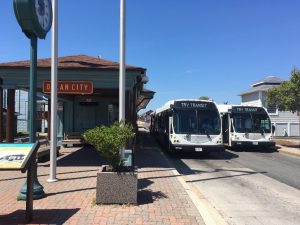
OCEAN CITY — As expected, municipal bus ridership in Ocean City took a huge hit last year due to the state restrictions and the public’s reticence for enclosed tight spaces, but the losses were offset somewhat by decreases in expenses.
The Ocean City Transportation Committee had before it on Tuesday an overview of ridership, revenue and expense figures for 2020 and no one appeared surprised by the sharp decline. Transit Director Mark Rickards said December 2020 was down about 41% compared to the same month last year. In terms of year-to-date ridership, the average month in 2020 was down around 70% to 80% percent. He said the December 2020 ridership numbers at a 41% decrease represented a flattening out of sorts.
“Looking at the seven-year average, 2020 was the lowest I think any of have ever seen, but it was expected with the circumstances,” he said. “Now, there is nowhere to go but up. It’s nothing to be ashamed of. We all did our jobs under difficult circumstances. We still had pretty good numbers in the summer with over 400,000 riders.”
Council Secretary and committee member Tony DeLuca said there was reason for optimism going forward.
“The uptick in encouraging,” he said. “It looks like the percentage of decline is flattening out. Are we going to be adding more deployment?”
Rickards said the current bare-bones deployment plan has 40-minute service times with one bus going north and one bus going south. Largely because of the current state restrictions on restaurant and bar stop times at 10 p.m., the service concludes each night at 11 p.m.
“That’s basically what we were doing last winter,” he said. “It cuts off at 11 p.m. and starts again at 6 a.m. We’re not adding deployments on the weekends for now. That will continue through April 11 unless things change between now and then. We might ramp up on St. Patrick’s weekend.”
Mayor Rick Meehan asked if the schedule could be adjusted if there are changes in the state restrictions between now and April.
“We are very flexible,” said Rickards. “We can ramp up pretty quickly if things change and restaurant hours change.”
Rickards explained on the revenue side, the town took an obvious hit, but not to the extent ridership numbers dropped. He said revenue was down around 73% compared to the 80% drop in ridership. However, payroll and operational expenses were down because of fewer deployments. In a nutshell, it appears ridership was down 80%, revenue was down 70% and expenses were down about 60%. All in all, Rickards said there was roughly $1.8 million in ridership fares lost because of COVID, but that loss was offset by cuts in expenses.
With the 2020 transit stats in the books, Public Works Director Hal Adkins said it was time for the “crystal ball” conversation about 2021. The current rules in place in Maryland for mass transit include the wearing of masks for patrons, drivers and staff, capacity limitations and wipes on buses. Adkins said deployment levels going forward will depend on the town’s direction with regards to marketing and tourism.
“We at public works don’t currently follow all of the issues with tourism,” he said. “What message are we sending out for spring and summer? That will affect what we do. We need to put ourselves in a position to be ready.”
In answer to a question about bus capacity, Operations Manager Steve Bartlett said the buses for the most part have been running at about 25 percent. He said the drivers have some discretion with their comfort level in terms of capacity. Meehan said those capacity limitations could be lifted somewhat if COVID restrictions are eased down the road.
“Looking forward, we should adopt a plan with no standing on the buses, with riders spaced were possible and wearing masks,” he said. “As long as everyone continues to wear masks and follow the other directives, we should get back to capacity seating with no standing.”
Bartlett said he had a core group of about 68-72 municipal bus drivers last year. In a typical year, the town seeks to employ and train about 160 drivers. Bartlett said the goal is to get back to that number, but there are still challenges.
“The process has become more complicated,” he said. “You have to have an appointment for anything at the DMV. You have to have appointments for the pre-screen drug tests. If somebody came to me fully-credentialed, it would still be a three-week process. We’re going to be starting at the end of the month and we hope to be at full-blown capacity by mid-March.”
In terms of ridership predictions for the coming season, Meehan said it will depend on what is going on with the pandemic.
“I don’t see people right now jumping back on public transportation,” he said. “I think it’s going to be a gradual thing until people get comfortable again.”
Rickards said it could take years to get ridership numbers back to pre-COVID levels.
“It will be a challenge to get our ridership back,” he said. “It will be a year-by-year process. It might take three years to come all the way back.
Adkins agreed, saying, “I think we’d be lucky to see a 30% increase this summer over last summer. I don’t see it jumping back by 50%. I’m just being realistic.”

